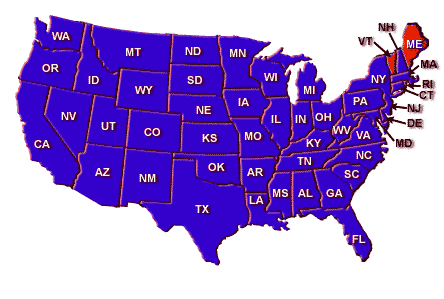The Republican Party met in Cleveland, Ohio, in June, 1936. Herbert Hoover, still a popular figure in the party, was greeted with wild applause when he appeared. As its 1936 candidate, the Republicans shows Alfred M. Landon, who had been elected governor of Kansas in 1934, the only Republican gubernatorial to be successful in the entire nation that year. Franklin D. Roosevelt was again nominated by the Democrats. With little chance that he would lose the election, he used the campaign to restate and defend his administration`s plans. In a speech in Chicago, on October 14, 1936, Roosevelt stated: "On this trip through the nation, I have talked to farmers. I have talked to miners, I have talked to industrial workers; and in all that I have seen and heard, one fact has been clear as crystal -- that they are part and parcel of a rounded whole, and that none of them can succeed in his chosen occupation if those in the other occupations fail in their prosperity. I have driven home that point. "Tonight, in this center of business, I give the same message to the businessmen of America -- to chose who make and sell the processed goods the nation uses and to the men and women who work for them. "To them I say: Do you have a deposit in a bank? It is safer today than it has ever been in our history. It is guaranteed. Last October 1 marked the end of the first full year in fifty-five years without a single failure of a national bank in the United States." Opposition of a less orthodox type than the Republican Party developed as well. Father Coughlan, a Catholic priest with a large radio audience estimated at 30 million people, became disillusioned with the New Deal after initially supporting it. Coughlan founded the National Union for Social Progress in November 1934 in opposition to the twin evils of capitalism and communism, both of which Coughlan declared to be rotten. The National Union attracted Dr. Francis Townsend, a retired physician from California, who advocated an old age pension as a means of solving old-age poverty and unemployment at the same time, by freeing jobs for young people. Huey P. Long advocated for a general redistribution of wealth and gravitated to the Union along with other radical thinkers. From this disparate group came a plan to run Long for president in 1936, but he was inconveniently assassinated on September 8, 1935. In the summer of 1936, the NUSP became the Union Party and held a national convention. Senator William E. Borah of Idaho participated and had some support. The nomination, however, went to Congressman William Lemke of North Dakota. The Union suffered from having three leaders -- Coughlan, Townsend, and Gordon L.K. Smith representing the Huey Long legacy. After receiving a minor number of votes in November 1936, the party largely disbanded in 1938. The Socialist Party again nominated Norman Thomas, who struggled to keep the platform of the party identified with positions significantly to the left of the Democrats. He succeeded, but the voting public did not regard the Socialist position as pragmatic and Thomas received fewer popular votes in 1936 than he did in 1932. The people responded to Roosevelt`s message. On election day, November 3, 1936, he was voted back into office in 1936 by the largest popular majority achieved by any presidential nominee up until that time. Winning 60.8% of the popular vote, Roosevelt received the electoral votes of all but two states, Maine and Vermont. Before that time, Maine had been considered a bellwether for the national results, and a popular saying had been, "As Maine goes, so goes the nation." In 1936, this was changed to, "As Maine goes, so goes Vermont." On Capitol Hill, the results were equally lopsided. Democrats emerged from the election of 1936 with 76 seats to just 16 for the Republicans. To the U.S. House of Representatives, the voters sent just 88 Republicans compared with 334 Democrats. National opinion polls were relatively new in 1936, but George Gallop and Elmo Roper both forecast a substantial victory for Roosevelt. Roosevelt`s campaign manager James A. Farley predicted to Roosevelt that in the 1936 election his boss would win every state except Vermont and Maine, which proved correct. The Literary Digest came to a different conclusion. Relying on outdated direct mail polling, the magazine concluded that Landon would defeat Roosevelt by 370 electoral votes to 171. Roosevelt`s landslide victory helped to put the Digest out of business.
| Election of 1936 Candidates |
Party
|
Electoral
Vote |
Popular
Vote |
| Franklin D. Roosevelt (N.Y.) John N. Garner (Texas) |
Democratic
|
523
|
27,476,673
|
| Alfred M. Landon (Kansas.) Frank Knox (Illinois) |
Republican
|
8
|
16,679,583
|
| William Lemke (North Dakota) Thomas C. O`Brian (Mass.) |
Union
|
0
|
892,793
|
